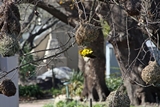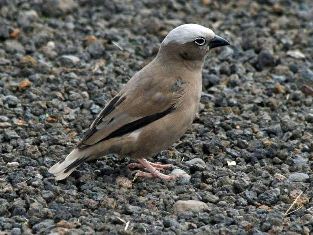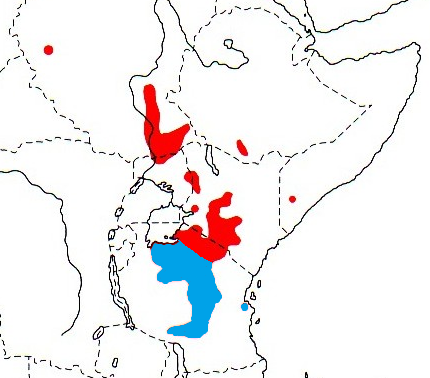Weaver news
|
Photo (left): adult Grey-headed Social Weaver, from Wikimedia Commons, by Dick Daniels. The Grey-headed Social Weaver Pseudonigrita arnaudi is named after the French collector M Arnaud, and the English name is based on the bird's plumage. It is a brownish bird with a conspicuous pale grey crown, white eye-ring and pale-tipped tail; the sexes are similar (photo left). It is found in bush and acacia woodland. The Grey-headed Social Weaver is similar to the only other species in its genus, the Black-capped Social Weaver - see Weaver Wednesday [6]. The two species can occur together, although the Grey-headed usually prefers wetter areas than the Black-capped.
Two subspecies of the Grey-headed Social Weaver are currently recognised (see map right, based on Birds of Africa):
The Grey-headed Social Weaver feed mostly on the ground, eating grass seeds and insects, the latter including grasshoppers, beetles, termites and caterpillars. They feed their young on soft green grass seeds and insects. Birds drink regularly. It is a colonial, monogamous, co-operative breeder. Several groups of 2-10 birds occupy a colony, each group having 2-8 nests, with up to 157 nests, sometimes touching, in a single tree. Sub-adult helpers may assist in feeding young. Breeding depends on rainfall and at some colonies, eggs laid in all months of the year.
The nest (photo left, from phown 3160) is built by both sexes and is a large, compact grass nest firmly attached to thin branches. The nest is symmetrical, with 2 openings below in roosting nests, but one entrance is closed when eggs are laid. The nest is made of straight grass stems, laid like thatch around a central cavity. Birds constantly add to and modify the nest. Incubation is by both sexes. Pairs with helpers raise more young than pairs without helpers. Old nests are used by Cut-throat Finches Amadina fasciata, while Chestnut Sparrows Passer eminibey actively take over new nests. There are 15 PHOWN records (see PHOWN summary), all of the nominate subspecies, and more PHOWN records are needed. Also look out for other bird species using their nests. Submit any weaver nest records to PHOWN (PHOtos of Weaver Nests) via the Virtual Museum upload site. PHOWN summary Previous Wedn: Spectacled Weaver Full weaver species list |













